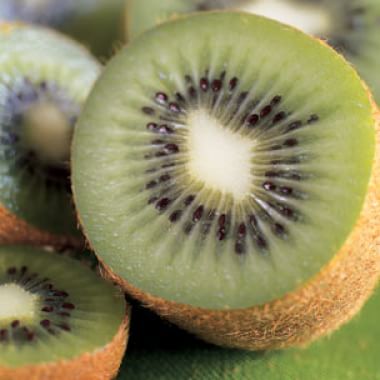
A relatively recent import from New Zealand, kiwifruit was once called the Chinese gooseberry. The small, egg-shaped fruit has a distinctive fuzzy brown peel and lime green flesh with a sunburst pattern of tiny black seeds.
Early on, the bright color, unique sweet-tart flavor and exotic pedigree of this fruit made it the darling of restaurant chefs. After appearing for years as garnishes on dramatic nouvelle cuisine plates, kiwifruits have now joined apples, bananas and oranges as standard fare in fruit bowls and salads. Kiwifruits can also be pureed and used as a sauce for desserts or frozen in a sorbet.
Selecting
Choose fruits heavy for their size and free of bruises. Like peaches, kiwifruits are ready for eating when they give to gentle pressure. Handle them with care, for they bruise easily. They are widely available year-round. The California crop peaks from winter to spring, while the New Zealand fruits appear in our markets in summer and fall.
Storing
Leave kiwifruits at room temperature until they soften. Accelerate the ripening by enclosing the fruits in a paper bag with an apple or a banana. Once kiwifruits are ripe, keep them in a plastic bag in the refrigerator for up to 1 week.
Preparing
Peel off the fuzzy skin with a vegetable peeler, using a gentle sawing motion. Or, if the fruit is soft and ripe, simply cut it in half and scoop out the flesh in one piece with a spoon. Slice a kiwifruit crosswise to highlight the pattern of its seeds.
Kiwifruit contains the same powerful tenderizing enzymes as papaya. Rub or marinate meats with kiwifruit before grilling or roasting.
Adapted from Williams-Sonoma Kitchen Companion (Time-Life Books, 2000).
Early on, the bright color, unique sweet-tart flavor and exotic pedigree of this fruit made it the darling of restaurant chefs. After appearing for years as garnishes on dramatic nouvelle cuisine plates, kiwifruits have now joined apples, bananas and oranges as standard fare in fruit bowls and salads. Kiwifruits can also be pureed and used as a sauce for desserts or frozen in a sorbet.
Selecting
Choose fruits heavy for their size and free of bruises. Like peaches, kiwifruits are ready for eating when they give to gentle pressure. Handle them with care, for they bruise easily. They are widely available year-round. The California crop peaks from winter to spring, while the New Zealand fruits appear in our markets in summer and fall.
Storing
Leave kiwifruits at room temperature until they soften. Accelerate the ripening by enclosing the fruits in a paper bag with an apple or a banana. Once kiwifruits are ripe, keep them in a plastic bag in the refrigerator for up to 1 week.
Preparing
Peel off the fuzzy skin with a vegetable peeler, using a gentle sawing motion. Or, if the fruit is soft and ripe, simply cut it in half and scoop out the flesh in one piece with a spoon. Slice a kiwifruit crosswise to highlight the pattern of its seeds.
Kiwifruit contains the same powerful tenderizing enzymes as papaya. Rub or marinate meats with kiwifruit before grilling or roasting.
Adapted from Williams-Sonoma Kitchen Companion (Time-Life Books, 2000).








